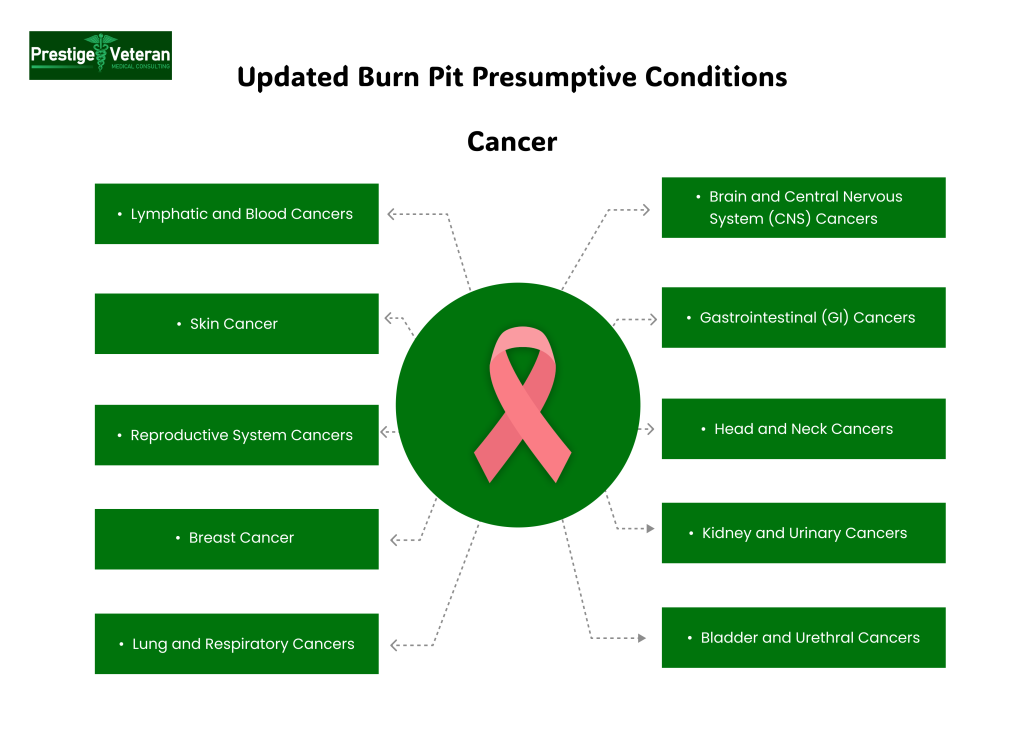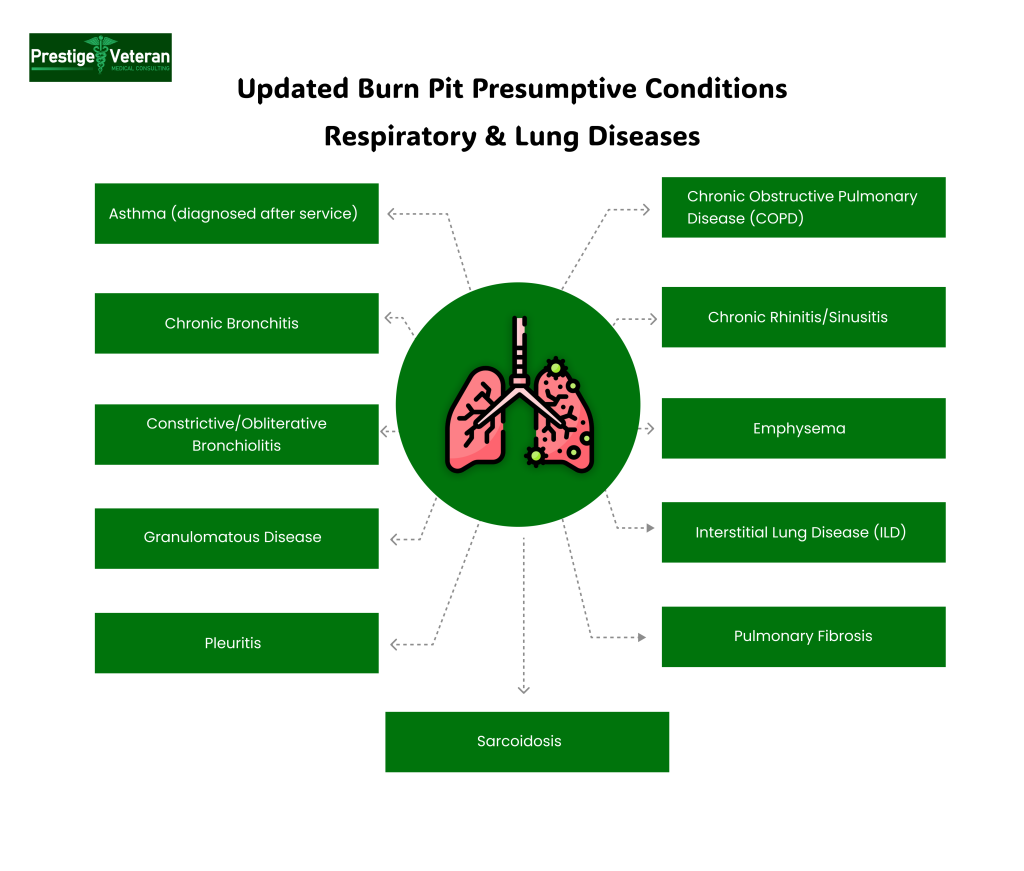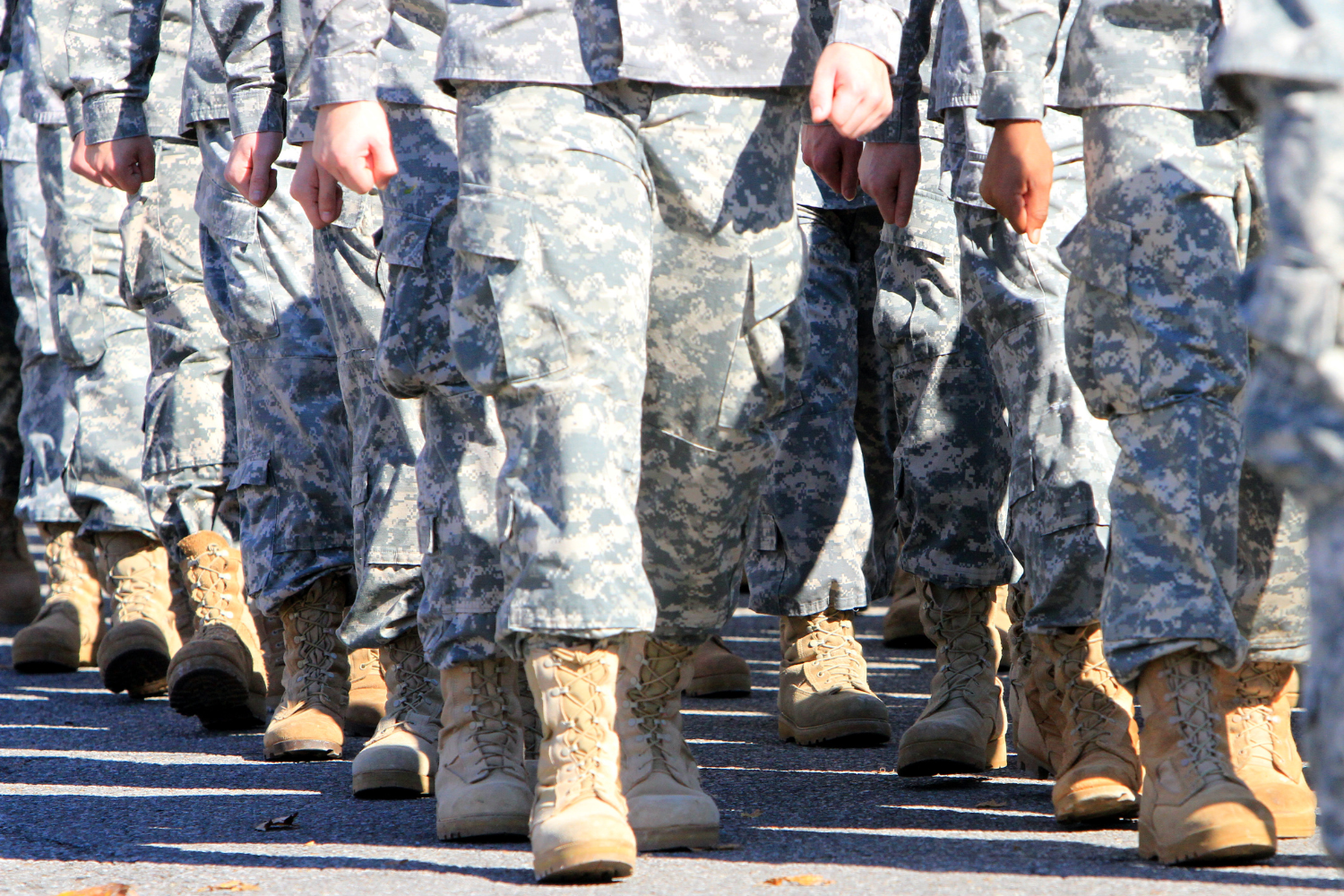Last Updated on July 21, 2025
For years, burn pits were a common waste disposal method in military operations, exposing thousands of service members to toxic smoke from burning plastics, chemicals, and ammunition. According to the U.S. Department of Defense, nearly 3.5 million service members are estimated to have been exposed to burn pits. Many later developed severe health conditions, now recognized by the Department of Veterans Affairs (VA) as presumptive, making it easier to access VA health care and benefits.
This guide covers the 2025 updated list of PACT Act burn pit presumptive conditions, eligibility criteria, the process of filing claims, and how to prove non-presumptive conditions. Whether you’re a veteran or assisting one, this blog helps navigate the VA benefits system.
Table of Contents
Burn Pits and Their Impact on Veterans
What Are Military Burn Pits?
Military burn pits were large open-air areas used to burn waste materials in deployed locations, particularly in Iraq, Afghanistan, Kuwait, and other Middle Eastern countries. These pits, some spanning ten acres or more, burned:
- Plastics and rubber
- Electronics and batteries
- Ammunition and explosives
- Medical and human waste
- Paints, solvents, and other toxic chemicals
- Petroleum and lubricant products
- Metal, aluminum cans, and other toxic substances
The lack of proper waste management infrastructure in deployed areas led to the extensive use of burn pits as the primary method of disposal. Unfortunately, the byproducts of combustion from these fires released dioxins, benzene, heavy metals, particulate matter, polycyclic aromatic hydrocarbons (PAHs), and volatile organic compounds (VOCs), which are known to cause severe health effects.
Studies suggest that chronic inhalation of toxic smoke can damage the lung lining and cause persistent inflammation, disrupt the immune system, increase the risk of DNA mutations, and impair neurological function.
Additionally, the National Academies of Sciences, Engineering, and Medicine (NASEM) and the International Agency for Research on Cancer (IARC), part of the WHO, have identified certain chemicals in burn pit emissions as known human carcinogens, substances that can cause cancer.
Health Effects of Burn Pit Exposure
The health impact of burn pit exposure depends on several factors, including proximity to the pits, duration and frequency of exposure, type of waste burned (food, plastics, or chemicals), environmental conditions, and any pre-existing respiratory issues.
Veterans who were stationed near burn pits or stationed downwind for extended periods frequently inhaled the toxic fumes released by burning waste, putting them at a significantly higher risk.
This exposure to burn pits has been linked to:
- Immediate symptoms: Chronic coughing, wheezing, difficulty breathing, headaches, and eye irritation
- Long-term conditions: Respiratory diseases, cardiovascular issues, cancers, and autoimmune disorders
- Neurological symptoms: Cognitive dysfunction, memory problems, and brain fog
\Researchers of Brown University analyzed the health records of nearly 500,000 Veterans, finding prolonged burn pit exposure increased risks of asthma, COPD, hypertension, and ischemic stroke.
These long-term effects often manifest years after deployment, making it difficult for veterans to link their illnesses directly to military burn pits.
VA’s Burn Pit Presumptive Conditions
The VA defines presumptive conditions as illnesses that are generally automatically considered service-connected due to overwhelming medical and scientific evidence linking them to military service. This means veterans do not need to prove direct causation between their condition and their exposure to burn pits if they meet specific criteria.
The PACT Act and Expanded Presumptive Conditions
The “Sergeant First Class Heath Robinson Honoring our Promise to Address Comprehensive Toxics Act of 2022” or the “Honoring our PACT Act of 2022” was a significant step forward in recognizing the effects of burn pit exposure. It expanded the list of presumptive conditions related to burn pits, ensuring that more veterans exposed to toxic substances receive the compensation and medical care they deserve.
The PACT Act added more than 33 new presumptive conditions related to burn pits and other toxic exposures, including cancers, respiratory diseases, and other serious conditions. This change expands VA disability benefits to the Gulf War era and post-9/11 veterans.
What are the Presumptive Conditions for Burn Pit Exposure Under the PACT Act?
In 2025, the VA recognizes the following burn pit presumptive conditions:
Cancers

- Brain cancer
- Gastrointestinal cancer of any type
- Glioblastoma
- Head cancer of any type
- Kidney cancer
- Lymphatic cancer of any type
- Lymphoma of any type
- Melanoma
- Neck cancer
- Pancreatic cancer
- Reproductive cancer of any type
- Squamous cell carcinoma of the larynx
- Squamous cell carcinoma of the trachea
- Adenocarcinoma of the trachea
- Salivary gland-type tumors of the trachea
- Adenosquamous carcinoma of the lung
- Large cell carcinoma of the lung
- Salivary gland-type tumors of the lung
- Sarcomatoid carcinoma of the lung
- Typical and atypical carcinoid of the lung
- Respiratory (breathing-related) cancer of any type
Respiratory / Other Illnesses

- Asthma (diagnosed after service)
- Chronic bronchitis
- Chronic obstructive pulmonary disease (COPD)
- Chronic rhinitis
- Chronic sinusitis
- Constrictive bronchiolitis or obliterative bronchiolitis
- Emphysema
- Granulomatous disease
- Interstitial lung disease (ILD)
- Pleuritis
- Pulmonary fibrosis
- Sarcoidosis
These PACT Act conditions are automatically presumed service-connected if a veteran served in a qualifying location and has an official medical diagnosis of any of these burn pit conditions.
The Department of Veterans Affairs reveals that it has granted nearly 73% of burn pit-related claims for asthma, sinusitis, and rhinitis.
Recently Added Presumptive Conditions
The VA continually evaluates scientific research and medical data to expand the list of presumptive conditions under the PACT Act. In 2024 and 2025, the VA announced new additions to the presumptive conditions list linked to burn pit and airborne hazard exposure, such as:
On June 14, 2024:
The VA added three rare cancers to the presumptive list:
- Male breast cancer
- Urethral cancer
- Cancer of the paraurethral glands
Citation: Department of Veterans Affairs, Interim Final Rule, Docket No. 2024-28190, 38 CFR § 3.320. Published in the Federal Register on June 14, 2024.
On January 2, 2025:
Genitourinary cancers were included, specifically:
- Urinary bladder cancer (including overlapping bladder sites)
- Ureter cancer (including the ureteric orifice and urachus)
Citation: Department of Veterans Affairs, Interim Final Rule, Docket No. 2024-31220, 38 CFR § 3.320a. Published in the Federal Register on January 2, 2025.
On January 10, 2025:
Several blood and lymphatic cancers were added:
- Acute and chronic leukemias (including Chronic Myelogenous Leukemia – CML)
- Multiple myeloma
- Myelodysplastic syndromes
- Myelofibrosis
Citation: Department of Veterans Affairs, Interim Final Rule, Docket No. 2024-31776, 38 CFR § 3.320b. Published in the Federal Register on January 10, 2025.
2024–2025 Updates to the VA Burn Pit Presumptive List
- 2024-06-14: VA added three cancers (male breast, urethral, paraurethral glands) – VA Press Release
- 2025-01-02: VA added urinary bladder and ureter cancers – Federal Register
- 2025-01-10: VA added acute and chronic leukemias, multiple myeloma, myelodysplastic syndromes, and myelofibrosis – Federal Register
This list reflects only the VA’s current burn pit and airborne hazard presumptive conditions under the PACT Act. The PACT Act covers many other presumptive conditions, including those linked to Agent Orange, atomic radiation, and other toxic exposures.
For the full scope of presumptives and eligibility rules, visit our PACT Act guide and review the VA’s official burn pit presumptive list.
Who Qualifies for Burn Pit Presumptive Benefits?
To qualify for burn pit presumptive benefits, a veteran must meet the following criteria:
Eligible Service Locations and Timeframes
To qualify for presumptive service connection due to burn pit exposure, veterans must have served in one or more of the following locations:
On or After September 11, 2001:
- Afghanistan
- Djibouti
- Egypt
- Jordan
- Lebanon
- Syria
- Uzbekistan
- Yemen
- The airspace above these locations
On or After August 2, 1990:
- Bahrain
- Iraq
- Kuwait
- Oman
- Qatar
- Saudi Arabia
- Somalia
- United Arab Emirates (UAE)
- The airspace above these locations
Active Duty, National Guard, or Reserves Status
Both active-duty service members and certain National Guard and Reserve members qualify for presumptive benefits.
Diagnosis of a Presumptive Condition
A veteran must have at least one of the PACT Act presumptive conditions listed by the VA and a medical diagnosis.
By meeting these criteria, veterans can bypass the burden of proving direct service connection and easily receive approval for VA disability compensation.
How to File a VA Disability Claim for Burn Pit Exposure
Filing a VA disability claim is an essential step for veterans with health conditions from toxic exposure during military service. The VA now recognizes burn pit presumptive conditions, simplifying the process for veterans to receive compensation. However, the process of filing a burn pit exposure claim requires detailed documentation, medical records, and service history.
Step 1: Verify Eligibility for a Burn Pits Exposure
Before filing a claim, veterans should confirm their eligibility. The 2022 PACT Act expanded VA benefits for veterans who served in Iraq, Afghanistan, and other Southwest Asia military zones with burn pits. If you served in these locations during specified timeframes and have a recognized burn pit presumptive condition, you are automatically considered for VA benefits and compensation, eliminating the need to prove direct exposure.
Step 2: Gather Medical Evidence
The VA requires an official medical diagnosis of a presumptive condition, such as burn pits related asthma, chronic bronchitis, COPD, lung cancer, or other recognized illnesses. Collect medical evidence such as:
- Medical records confirming the presumptive condition’s diagnosis.
- Treatment history, including medications, surgeries, and therapies.
- Doctor’s notes outlining burn pit symptoms, limitations, and progression of the disease.
Veterans may also request a nexus letter from a qualified physician or specialist, such as an oncologist, when applicable, particularly if their condition is not on the presumptive list. This medical opinion should state that the veteran’s condition is “at least as likely as not” caused by exposure to burn pits.
Step 3: Provide Service Records
Proof of service in an eligible location is crucial for demonstrating you’re qualified to receive VA benefits. Veterans exposed to toxic substances should consider providing:
- DD-214 form listing deployment locations.
- Deployment and unit records showing time spent near burn pits.
- Buddy statements from fellow service members confirming toxic exposure.
Step 4: Submit the VA Disability Claim
The VA offers multiple ways to file a disability claim:
- Online: Veterans can submit their claim through the VA.gov website.
- By Mail: VA Form 21-526EZ should be sent to the VA’s claims processing center.
- In-Person: Visit a VA Regional Office to file the claim with assistance.
- Through a VSO (Veterans Service Officer): Many organizations, such as the DAV and VFW, offer free assistance in filing veterans’ disability claims.
Step 5: Attend Compensation & Pension (C&P) Exam
Most claims require a C&P exam, where a VA-appointed examiner assesses the severity of the condition and its impact on daily life. Veterans should be honest and detailed about their burn pit symptoms, including occupational and social impairment.
For example, if you’re a veteran exposed to burn pits in Iraq and have developed chronic bronchitis, describe symptoms like persistent coughing, shortness of breath, and work limitations during your C&P exam. This ensures the VA accurately evaluates your condition and grants a fair disability rating.
Step 6: Wait for the Claim Decision
The Department of Veterans Affairs typically takes several months to process a claim.
Veterans can check their claim status online through the official website, by calling 1-800-827-1000, or by visiting a VA regional office.
If approved, the veteran will receive a disability rating from 0% to 100%, determining the monthly compensation amount. If denied, veterans have the right to appeal the decision, providing additional evidence or requesting a higher rating.
Filing a VA claim for burn pit exposure can be complex, but with the right documentation and support, veterans can receive the compensation and health care they deserve.
How Much Compensation Can You Receive for Burn Pit Exposure?
The amount of VA disability compensation a veteran can receive for burn pit-related conditions depends on the assigned disability rating, ranging from 0% to 100%. The VA evaluates the severity of the condition and its impact on daily life when determining compensation. More debilitating conditions receive higher ratings.
VA Disability Ratings for Burn Pit-Related Conditions
Each presumptive condition linked to military burn pits has a specific rating based on the VA’s Schedule for Rating Disabilities (VASRD). Most of the respiratory conditions are rated under 38 CFR § 4.97 – Schedule of ratings—respiratory system.
Here is a table showing the VA ratings for all presumptive disabilities:
| Conditions | Diagnostic Code | Rating Criteria |
| Asthma (Diagnosed After Service) | 6602 | 10%, 30%, 60%, or 100% based on FEV1, FVC, exacerbations, and corticosteroid use |
| Chronic Bronchitis | 6600 | 10%, 30%, 60%, or 100% based on FEV1 levels, oxygen therapy, and PFTs |
| Chronic Obstructive Pulmonary Disease (COPD) | 6604 | 10%, 30%, 60%, and 100% depending on FEV1, FEV1/FVC ratio, oxygen dependence, and exercise tolerance |
| Chronic Rhinitis | 6522 | 10% for partial nasal obstruction, 30% for total obstruction with polyps |
| Chronic Sinusitis | 6510-6514 | 10% for mild cases, 30% for frequent infections, 50% for severe cases requiring surgeries |
| Constrictive Bronchiolitis/Obliterative Bronchiolitis | 6600-6604 (analogous rating) | 10% to 100%, based on lung function tests and oxygen therapy requirements |
| Emphysema | 6603 | 10%, 30%, 60%, and 100%, based on PFT results and oxygen dependence |
| Granulomatous Disease | 6822 | 10%, 30%, 60%, and 100%, based on pulmonary impairment, fibrosis, or granuloma formation |
| Interstitial Lung Disease (ILD) | 6825-6833 | 10% to 100%, based on oxygen dependence, pulmonary hypertension, and fibrosis progression |
| Pleuritis | 6732 | 10%, 30%, 60%, and 100%, depending on lung impairment, chronic pain, and breathing limitations |
| Pulmonary Fibrosis | 6825-6833 | 10% to 100% under the General Formula for Interstitial Lung Disease based on lung function tests and oxygen therapy |
| Sarcoidosis | 6846 | 0% to 100%, with 30% for moderate cases, 60% for severe respiratory issues, and 100% for organ failure or continuous oxygen therapy |
| Hypertension | 7101 | Rated at 10%, 20%, 40%, and 60% based on blood pressure levels |
| MGUS | 7712 | Rated at 0% asymptomatic, 100% if it progresses to multiple myeloma |
| All Types of Cancer | 8003, 7343, 6819, 7528, 7709, 7833, 7700, 7702, 7627 | Each is rated at 100% if active and for six months post-treatment. Subsequent ratings are based on residuals. |
2025 VA Disability Compensation Rates
The 2025 VA Disability Compensation Rates reflect a 2.5% cost-of-living adjustment (COLA), effective December 1, 2024. Typically, the compensation amount depends on disability rating and dependents. Here are estimated monthly payments for a veteran with no dependents:
- 0% disability rating: $0.00 per month
- 10% disability rating: $175.51 per month
- 20% disability rating: $346.95 per month
- 30% disability rating: $537.42 per month
- 40% disability rating: $774.16 per month
- 50% disability rating: $1,102.04 per month
- 60% disability rating: $1,395.93 per month
- 70% disability rating: $1,759.19 per month
- 80% disability rating: $2,044.89 per month
- 90% disability rating: $2,297.96 per month
- 100% disability rating: $3,831.30 per month
For veterans with dependents, additional compensation is provided for spouses, children, or parents. A 100% disabled veteran with dependents can receive over $4,000 per month.
Veterans who cannot work due to their disability may qualify for Total Disability Individual Unemployability (TDIU), which pays at the 100% rate. Moreover, veterans with multiple disabilities related to burn pits can receive a combined rating, which may increase overall compensation.
Receiving VA compensation for burn pit exposure can provide financial relief and access to healthcare for affected veterans.
Case Study: Gulf War Veteran Receives 100% VA Rating for Burn Pit-Linked Lung Cancer
Master Sergeant David H., deployed to Kuwait and Iraq during the Gulf War, never thought years of exposure to burn pits would catch up with him. Two decades later, he was diagnosed with adenocarcinoma of the lung, a condition recently added to the VA’s presumptive list under the PACT Act.
Initially unaware he could qualify, David only filed a VA disability claim after learning his cancer was now recognized as service-connected. With support from a VSO, he submitted his diagnosis, service records, and deployment history. Given the severity and type of burn pit cancer, the VA granted him a 100% disability rating within eight weeks.
David’s case shows how the expanded burn pit presumptive conditions under the PACT Act are making it easier for veterans with serious illnesses, often diagnosed long after service, to access full VA compensation and healthcare.
What If Your Condition Isn’t on the Presumptive List?
Not all conditions related to burn pit exposure are presumptive. For example, some of the conditions not presumed to be service-connected to burn pits exposure are:
- Neurological disorders (Parkinson’s disease, migraines, multiple sclerosis)
- Autoimmune diseases (rheumatoid arthritis, lupus, inflammatory bowel diseases)
- Cardiovascular diseases (hypertension, stroke)
- Mental health conditions like Post-traumatic stress disorder (PTSD) or depression
- Gastrointestinal problems (IBS, GERD)
- Chronic fatigue syndrome
- Thyroid dysfunction
- Sleep apnea
- Skin disorders
- Kidney or liver diseases
If your condition is not on the PACT Act presumptive conditions list, you can still file a claim by providing additional evidence to demonstrate service connection.
The Department of Veterans Affairs and the National Academies continue to review new research. As stronger scientific links are established, more conditions, such as those listed above, may be added to the presumptive list. Subscribe to the VA newsletter or check the Federal Register for future policy updates.
How to Prove Non-Presumptive Service Connection for Burn Pits
- Obtain a Medical Diagnosis – A confirmed diagnosis is essential before filing a claim.
- Provide Proof of Burn Pit Exposure – Submit service records, deployment orders, Military Occupational Specialties (MOS) records, or buddy statements verifying that you served near burn pits.
- Get a Nexus Letter – A doctor’s statement explaining that your condition is “at least as likely as not” linked to burn pit exposure may support the non-presumptive claim.
- Submit Research or Medical Studies – Provide scientific evidence supporting a connection between your condition and burn pit exposure.
- Register with the Airborne Hazards and Open Burn Pit Registry – Enrolling in this VA registry documents your exposure history and helps support claims for burn pit-related conditions.
- Document Effects of Ongoing Burn Pit Symptoms – Submit updated VA and private medical records, imaging scans, PFT results, and personal symptom journals to demonstrate the long-term impact of burn pit smoke on your health. You can also submit employment records or statements from fellow service members to show missed workdays or affected job performance.
Appealing a Denied VA Claim
If your VA claim is denied due to insufficient evidence, don’t lose hope—you have options to appeal. Strengthen your case by submitting additional medical opinions, research, or a nexus letter linking your condition to service-related exposure. You can also request a Board of Veterans’ Appeals hearing to present your case.
Seeking guidance from a Veterans Service Organization (VSO) or a VA-accredited attorney specializing in burn pit exposure claims can significantly improve your chances of approval.
Participating in the Burn Pit Registry
The Airborne Hazards and Open Burn Pit Registry (AHOBPR) is a VA initiative that allows veterans and service members to document their exposure to burn pits and other airborne hazards during military service. If you’re diagnosed with a condition not related to PACT Act burn pit presumptive disabilities, participating in this registry can help the VA better understand, research, and improve treatment for the long-term health effects of burn pits.
While enrollment in VA Burn Pit Registry does not automatically grant disability benefits, it provides essential documentation that may support a future claim. The Open Burn Pit Registry provides the following:
- Creates an official record of exposure
- May strengthen future VA disability claims
- Offers an optional, free VA health evaluation with notes that veterans can save and submit to support their disability claim.
- Contribute to ongoing research on toxic exposures
How to Register
If you haven’t yet enrolled, you can sign up at VA.gov. and complete an exposure questionnaire. After registration, a VA healthcare provider may conduct a free medical evaluation, though this is separate from the C&P exam required for disability claims.
Conclusion
Burn pit exposure has left many veterans facing serious health concerns, but the PACT Act has made it easier to receive VA benefits. If you’re experiencing toxic exposure symptoms, don’t wait—seek medical care, document your condition, and file a claim. Even if your illness isn’t on the presumptive list, you can still establish a service connection with strong evidence. Consider working with a VSO to maximize your chances of securing the VA benefits you deserve.
FAQs
What are burn pits?
A burn pit is a large open-air area used by the military to incinerate waste such as plastics, chemicals, ammunition, and medical or human waste, especially in deployed locations like Iraq and Afghanistan.
What is a presumptive condition related to burn pit exposure?
A presumptive condition for military burn pits is a disease or illness that the VA automatically considers service-connected due to strong medical evidence linking it to toxic exposure during military service.
What includes the VA burn pit presumptive conditions list 2025?
The VA burn pit presumptive conditions under the PACT Act include over 33 respiratory illnesses and cancers such as asthma, COPD, kidney cancer, lymphoma, gastrointestinal cancer, and several others linked to toxic exposure from burn pits during military service in Iraq, Afghanistan, and other qualifying locations.
What are the 23 presumptive conditions recognized in the PACT Act?
In 2025, the PACT Act includes over 33 presumptive conditions related to burn pits, such as asthma, chronic bronchitis, COPD, pulmonary fibrosis, interstitial lung disease, and multiple cancers, including brain, kidney, and gastrointestinal cancers.
What are presumptive cancers linked to burn pit exposure?
Presumptive cancers include leukemia, brain cancer, kidney cancer, lymphoma, multiple myeloma, pancreatic cancer, reproductive cancers, and lung cancer subtypes like adenocarcinoma and sarcomatoid carcinoma.
What conditions are related to burn pits?
Conditions related to burn pits include respiratory diseases (asthma, COPD, chronic bronchitis), lung diseases (pulmonary fibrosis, sarcoidosis), and various cancers (brain, kidney, gastrointestinal, and reproductive)
How do I file a VA disability claim for burn pit exposure?
To file a VA disability claim for burn pit exposure, veterans must submit medical evidence of a presumptive condition, proof of service in a qualifying location, and complete VA Form 21-526EZ either online, by mail, in-person, or with the help of a Veterans Service Officer (VSO).
Who qualifies for VA burn pit exposure benefits?
Veterans qualify for VA burn pit exposure benefits if they served in eligible locations such as Iraq, Afghanistan, Southwest Asia, or Middle Eastern countries after 1990 or 9/11 and have a diagnosed PACT Act presumptive condition recognized by the VA.
What compensation can veterans receive for burn pit-related disabilities in 2025?
In 2025, VA disability compensation for burn pit-related conditions ranges from $175.51 per month for a 10% rating up to $3,831.30 per month for a 100% rating, with additional pay for dependents and eligibility for Total Disability Individual Unemployability (TDIU).
Can I get VA benefits if my burn pit-related condition isn’t on the PACT Act presumptive list?
Yes, veterans can still receive VA benefits for non-presumptive burn pit-related conditions by submitting medical evidence, service records, a nexus letter from a physician, and supporting scientific research to prove the condition is service-connected.
Is hypertension a presumptive condition for burn pits?
No, hypertension is not a presumptive condition for burn pit exposure under the PACT Act; however, it is recognized for Vietnam-era veterans exposed to Agent Orange.
Also read: VA Presumptive Conditions and Nexus Letters
At Prestige Veteran Medical Consulting, a veteran-owned company, we specialize in Independent Medical Opinions (IMOs) known as Nexus letters.
Our purpose is to empower YOU, the veteran, to take charge of your medical evidence and provide you with valuable educational tools and research to guide you on your journey.
Understanding the unique challenges veterans face, our commitment lies in delivering exceptional service and support.
Leveraging an extensive network of licensed independent medical professionals, all well-versed in the medical professional aspects of the VA claims process, we review the necessary medical evidence to incorporate in our reports related to your VA Disability Claim.
Prestige Veteran Medical Consulting is not a law firm, accredited claims agent, or affiliated with the Veterans Administration or Veterans Services Organizations. However, we are happy to discuss your case with your accredited VA legal professional.













